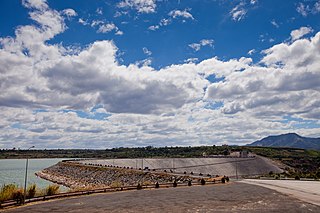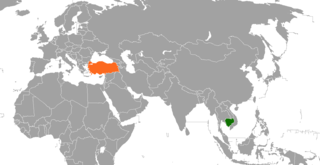This article lists all power stations in Cambodia .
| Power Plant | Capacity (MW) | Units | Year completed |
|---|---|---|---|
| Sihanoukville II | 270 | 2 x 135 MW | 2015 |
| Sihanoukville I | 100 | 2 x 50 MW | 2014 |
| Hydroelectric station | Capacity (MW) | Units | Year completed |
|---|---|---|---|
| Russei Chrum Krom | 338 | 2015 | |
| Stung Tatay | 246 | 3 x 82 MW | 2014 |
| Kamchay 1 | 193.2 | 3 x 64.4 MW | 2011 |
| Stung Atay | 120 | 4 x 25 MW, 2 x 10 | 2014 |
| Kamchay 2 | 10.1 | 3 x 3.1 MW, 1 x 800 kW | 2009 |
| Kirirom 3 | 18 | 2 x 9 MW | 2013 |
| Kirirom 1 Hydropower Dam | 12 | 2 x 6 MW | 1965 |
| O Chum 2 Hydropower Dam | 1 | 1992 | |
| Lower Se San 2 Dam | 400 | 5 x 80 MW | 2017 |

The economy of Cambodia currently follows an open market system and has seen rapid economic progress in the last decade. Cambodia had a GDP of $24.57 billion in 2018. Per capita income, although rapidly increasing, is low compared with most neighboring countries. Cambodia's two largest industries are textiles and tourism, while agricultural activities remain the main source of income for many Cambodians living in rural areas. The service sector is heavily concentrated on trading activities and catering-related services. Recently, Cambodia has reported that oil and natural gas reserves have been found off-shore.

Cambodia, officially the Kingdom of Cambodia, is a country located in the southern portion of the Indochinese Peninsula in Southeast Asia. It is 181,035 square kilometres in area, bordered by Thailand to the northwest, Laos to the north, Vietnam to the east, the Gulf of Thailand to the southwest, and maritime borders with Thailand, Malaysia and Indonesia. Phnom Penh is the nation's capital and largest city.

The Yali Falls Dam is the second largest dam in Vietnam, located in Gia Lai and Kon Tum provinces on the Krong Poko, a tributary of the Sesan River, in the Central Highlands of Vietnam, about 70 kilometres (43 mi) upstream of the Cambodian border. The 69-metre (226 ft)-high dam was begun in 1993 and sealed in 1996, with the 64.5 square kilometres (24.9 sq mi) reservoir filled by 1998. It aims to generate 720 MW of hydropower.
A Commerce minister is a position in many governments that is responsible for regulating external trade and promoting economic growth. In many countries, this role is separate from a finance minister, who has more budgetary responsibilities.
James Alexander Malcolm Caldwell was a British academic and a prolific Marxist writer. He was a consistent critic of American foreign policy, a campaigner for Asian communist and socialist movements and a supporter of the Khmer Rouge. Caldwell was murdered under mysterious circumstances a few hours after meeting Pol Pot in Cambodia.
The Cebu Declaration on East Asian Energy Security was signed by 16 nations after a three-hour meeting of delegates at the East Asia Summit in Cebu on January 15, 2007. The countries have agreed to promote energy security and find energy alternatives to conventional fuels.

The United Nations Transitional Authority in Cambodia (UNTAC) was a United Nations peacekeeping operation in Cambodia in 1992–93 formed following the 1991 Paris Peace Accords. This was the first occasion in which the UN directly assumed responsibility for the administration of an outright independent state, rather than simply monitoring or supervising the area. The UN transitional authority organised and ran elections, had its own radio station and jail, and was responsible for promoting and safeguarding human rights at the national level.

The following outline is provided as an overview of and topical guide to Cambodia:
In 2006, Cambodia's mineral resources remained, to a large extent, unexplored. Between 2003 and 2006, however, foreign investors from Australia, China, South Korea, Thailand, and the United States began to express their interest in Cambodia's potential for offshore oil and gas as well as such land-based metallic minerals as bauxite, copper, gold, and iron ore, and such industrial minerals as gemstones and limestone.
The Ministry of Mines and Energy is a government ministry responsible for governing and the mining industry and the energy industry of Cambodia. It is located in Phnom Penh.
The Electricity Authority of Cambodia (EAC) is an autonomous government agency responsible for managing and administering the provision of electric power in Cambodia.
The Sambor Dam is a proposed dam and hydroelectric power station on the Mekong River south of Sambor village in Prek Kampi District, Kratie Province, Cambodia. If built, it would be the lowest dam of the Mekong's mainstream dams, and largest in Cambodia.
The Stung Battambang 1 is a dam planned for construction on the Battambang River in Cambodia. The river is a major tributary of the Tonlé Sap. Of the two dams planned for this river, the larger is the Stung Battambang 1. A letter of commitment has been issued by the Cambodian authorities for a pre-feasibility study of the dam by an unknown Korean company
The Kirirom 1 Dam is an embankment dam located in the Kirirom National Park of Koh Kong Province, Cambodia
The Lower Se San 2 Dam is a hydroelectric dam under development on the Se San River in Stung Treng Province, northeastern Cambodia. The Se San River is a major tributary of the Mekong River. The dam site is located 25 kilometres (16 mi) east of the provincial capital, also named Stung Treng. The first turbine began producing electricity in November 2017. The dam was officially opened on December 18, 2018.
The Lower Se San/Sre Pok 2 scheme is a proposed hydroelectric dam to be located in Stung Treng Province, Cambodia on the Tonle Sre Pok some 2 kilometres (1.2 mi) upstream of its confluence with the Se San, and about 37 kilometres (23 mi) upstream of the confluence of the combined Sre Pok, Se San and Se Kong rivers with the Mekong mainstream.
Stung Sen Dam is a proposed multipurpose dam to be located on the Stung Sen River. The river originates in Preah Vihear and flows to the Tonlé Sap Lake in Kompong Thom, southeast of Phnom Rovieng, Cambodia. Under MoU study project and Feasibility Study by Korean company. The large reservoir would submerge Kompong Putrea. Exact data for reservoir size and number of displaced people is not available, nor is any information on the importance of the Stung Sen's flow to the Tonle Sap Lake or fisheries.
Cambodia had a total primary energy supply (TPES) of 5.48 Mtoe in 2012. Electricity consumption was 3.06 TWh. About one third of the energy came from oil products and about two thirds from biofuels and waste.

Cambodia–Turkey relations are the foreign relations between Cambodia and Turkey. Diplomatic relations at the legation level were established in 1947 and then to the rank of ambassador in 1959. It was not until 2013, however, that Turkey established a resident embassy in Cambodia's capital, Phnom Penh.